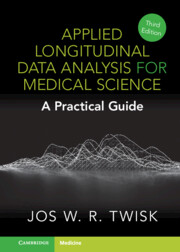Book contents
- Applied Longitudinal Data Analysis for Medical Science
- Applied Longitudinal Data Analysis for Medical Science
- Copyright page
- Dedication
- Content
- Preface
- Acknowledgements
- Chapter 1 Introduction
- Chapter 2 Continuous Outcome Variables
- Chapter 3 Continuous Outcome Variables: Regression-based Methods
- Chapter 4 The Modelling of Time
- Chapter 5 Models to Disentangle the Between- and Within-subjects Relationship
- Chapter 6 Causality in Observational Longitudinal Studies
- Chapter 7 Dichotomous Outcome Variables
- Chapter 8 Categorical and Count Outcome Variables
- Chapter 9 Outcome Variables with Floor or Ceiling Effects
- Chapter 10 Analysis of Longitudinal Intervention Studies
- Chapter 11 Missing Data in Longitudinal Studies
- Chapter 12 Sample Size Calculations
- Chapter 13 Software for Longitudinal Data Analysis
- References
- Index
Chapter 9 - Outcome Variables with Floor or Ceiling Effects
Published online by Cambridge University Press: 20 April 2023
- Applied Longitudinal Data Analysis for Medical Science
- Applied Longitudinal Data Analysis for Medical Science
- Copyright page
- Dedication
- Content
- Preface
- Acknowledgements
- Chapter 1 Introduction
- Chapter 2 Continuous Outcome Variables
- Chapter 3 Continuous Outcome Variables: Regression-based Methods
- Chapter 4 The Modelling of Time
- Chapter 5 Models to Disentangle the Between- and Within-subjects Relationship
- Chapter 6 Causality in Observational Longitudinal Studies
- Chapter 7 Dichotomous Outcome Variables
- Chapter 8 Categorical and Count Outcome Variables
- Chapter 9 Outcome Variables with Floor or Ceiling Effects
- Chapter 10 Analysis of Longitudinal Intervention Studies
- Chapter 11 Missing Data in Longitudinal Studies
- Chapter 12 Sample Size Calculations
- Chapter 13 Software for Longitudinal Data Analysis
- References
- Index
Summary
When the development over time is analysed in a particular continuous outcome variable, it is quite common that the variable reaches either a ceiling or a floor. When floor or ceiling effects occurs, standard regression-based methods are not suitable for the longitudinal data analysis. To analyse outcome variables with floor or ceiling effects, two-part models can be used. In Chapter 9 it is explained that a distinction can be made between the standard two-part models and the joint two-part models. For the standard two-part models, the process which is studied is seen as two separate processes. One process reaching the floor or ceiling or not and one process for the observations not reaching the floor or ceiling. For the joint two-part models the process which is studied is seen as one process. When the outcome variable has a latent normal distribution, tobit mixed model analysis can be used. A latent normal distribution means that the outcome variable has a normal distribution, but part of that normal distribution cannot be measured and will have the same (floor or ceiling) value for all observations. The advantage of a tobit mixed model analysis is that the regression coefficient of the analysis has the same interpretation as the regression coefficient obtained from a standard mixed model analysis .Although tobit mixed model analysis is not used extensively in medical studies, it has very nice features. Also in this chapter, all methods are accompanied by extensive real-life data examples.
Keywords
- Type
- Chapter
- Information
- Applied Longitudinal Data Analysis for Medical ScienceA Practical Guide, pp. 152 - 163Publisher: Cambridge University PressPrint publication year: 2023



